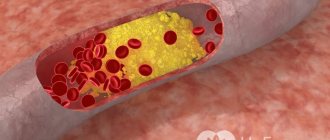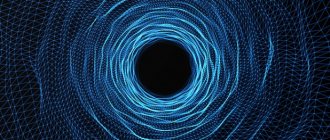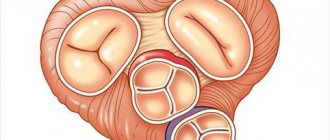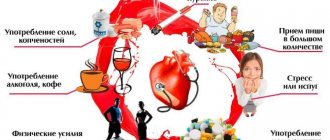Svetlana Shcherbakova
Cardiologist
Higher education:
Cardiologist
Kabardino-Balkarian State University named after. HM. Berbekova, Faculty of Medicine (KBSU) Level of education – Specialist 1994-2000
Additional education:
“Cardiology”
State Educational Institution “Institute for Advanced Training of Physicians” of the Ministry of Health and Social Development of Chuvashia
Contacts
Ischemic crisis is a pathological condition that occurs when circulatory processes in the heart and brain are disrupted. This condition is one of the variants of cerebral hypertensive crisis, which is based on hypertension. A crisis can also develop against the background of a pathological disorder such as symptomatic arterial hypertension.
Among the features of the pathogenesis of ischemic crisis, it is possible to single out spasm of the vascular structures of the brain, which occurs against the background of an increase in blood pressure. Such a reaction is fraught with a sharp weakening of blood flow in the brain area, which can lead to the development of soft tissue ischemia.
Symptoms of ischemic crisis
This condition develops much less frequently than the angiohypotonic form of pathological disorders. Clinicians have not yet fully studied such disorders of the body, so they show special interest in patients with ischemic crisis.
Hypertensive patients and people in whom high blood pressure does not cause much discomfort are more susceptible to the development of ischemic crisis than others. Such patients may not have such a common symptom as headache.
A crisis develops when blood pressure readings go off scale (from 140/100 or more). The pressure can rise to such an extent that the tonometer scale is not able to record its readings.
Features of ischemic crisis:
- The initial stages of development may not produce any symptoms.
- Primary signs may be non-specific and regarded as disruptions in the psycho-emotional state.
- Early symptoms are characterized by emotional lability, in which excitation processes predominate.
- There may be a state of euphoria or increased energy that was not previously characteristic of the person.
- The possibility of increased irritability and symptoms such as excessive tearfulness cannot be ruled out.
- The patient experiences excessive sweating and fear. Tachycardia, nausea and even vomiting are possible.
- A person may become too harsh and even aggressive.
The attack tends to be localized. This process is characterized by the development of focal neurological symptoms. The development of further symptoms depends on the location of the disorders, as well as the extent of the affected area. We are talking about the appearance of symptoms such as impaired visual function (a feeling of pressure, “floaters” before the eyes), sensitivity disorders of various parts of the body, unsteadiness of gait and general disorientation. Some patients experience disturbances in the articulation of the speech apparatus and facial asymmetry.
Please note that the symptoms of ischemic crisis may be hidden. There are no complaints. This occurs against the background of an unstable mental sphere, which is characterized by a decrease in self-criticism. The primary manifestations of an ischemic crisis can be noticed by close people or relatives of the patient, who seek medical help.
Types of vascular crises
The disease is not uniform in its development mechanism and manifestations. Depending on the condition of the cerebral vessels, the following are distinguished:
- with reduced venous tone (angiohypotonic) – blood accumulates in the dilated veins of the brain, intracranial pressure increases;
- with increased arterial tone (ischemic) - due to pronounced vascular spasm (in response to high pressure), the flow of blood into the brain cells is disrupted;
- combined - begins with angiohypotonic, and then ischemia joins it due to the discharge of blood from the arterial into the venous network, bypassing the capillaries.
Reasons for development
An ischemic attack is sudden and occurs due to the influence of negative factors on the body:
- Stressful situations and severe fatigue.
- Overheating of the body and weather sensitivity.
- Drinking alcoholic beverages.
- The presence of a large amount of salty foods in the diet.
- Untimely use of antihypertensive drugs for medical reasons.
Ischemic stroke develops mainly against the background of hypertension. This happens most often when we are talking about severe malignancy of the course. Hypertensive crisis occurs mainly in women during menopause. But that doesn't mean men shouldn't worry about it.
Many patients are not even aware of high blood pressure. They attribute the symptoms of ischemic crisis to high mental stress or fatigue.
In 1% of patients with hypertension, an ischemic crisis develops. This is preceded by a violation of recommendations for taking medications that regulate blood pressure. The attack may continue for a couple of hours or several days.
Symptoms characteristic of each subtype of pathology
Complex crisis
An increase in blood pressure is the impetus for the development of this condition in a patient.
This subtype of crisis at the initial stage is characterized by angiohypotonic manifestations, but it develops already at a significantly increased level of blood pressure. Over time, the symptoms become focal, which is characteristic of the ischemic type of hypertensive cerebral crisis. The characteristics of the manifestations depend on the location of the areas of the brain that have been attacked.
Angiohypotonic
The main signal about the development of this type of pathology is a painful sensation in the back of the head. At the initial stage, people do not pay due attention to this, attributing it to fatigue or weather conditions. However, you should be wary if the pain begins to intensify when the body is in a horizontal position, but recedes for a short time in a vertical position. The spread of unpleasant sensations to the eyeballs indicates a deterioration in the person’s condition. Auxiliary signs by which hypertensive cerebral crisis can be identified are:
- nausea;
- vomit;
- excessive sweating;
- wave-like breathing;
- tachycardia;
- facial cyanosis;
- nystagmus;
- tendon reflex disorder;
- absent-mindedness.
Ischemic
Increased emotionality in a person may be a sign of this form of pathology.
This type of pathology is diagnosed much less frequently than the previous one and mainly in hypertensive patients who did not suffer from headaches when blood pressure readings increased. Clinical manifestations may be vague for a long time and appear only over time. The main symptoms include:
- mental disorders (increased activity, emotionality);
- decreased vision;
- numbness of the limbs;
- poor coordination of movements;
- speech apparatus disorders.
Risk group
The risk group includes people who, against the background of high blood pressure, may suddenly experience irreversible changes in the body.
Among the main risk factors are:
- Hereditary predisposition.
- Obesity or even slight weight gain.
- Use of hormonal contraceptives.
- Excessive passion for alcoholic beverages.
- Undergoing treatment with non-steroidal medications.
- Cardiac dysfunctions: coronary syndrome, cardiac asthma.
- Prostate adenoma causing insufficient urination.
- Disturbance of circulatory processes in the kidneys in the presence of renal failure.
People with a disease such as ischemic disease are more susceptible to the development of an ischemic crisis than others. The development of pathological disorders in the body can only be prevented with the help of competent and long-term drug therapy. IHD is not a death sentence. Only in this case does a person need constant monitoring of blood pressure, which allows timely action to be taken.
Hospitalization and therapeutic intervention methods
The therapeutic approach to cerebral crisis, as a complication of high blood pressure, depends on the type of its manifestation, for example, the development of mixed or ischemic is a serious reason for urgent hospitalization of a person.
Before the ambulance arrives, doctors recommend:
- Take a warm foot bath (expands the vascular lumen, which helps normalize blood pressure).
- Take a pill to normalize blood pressure, but the decrease in blood pressure should be gentle.
- Diuretics are effective for headaches.
- Heart pain is relieved with Nitroglycerin or Validol.
- If fever occurs, cover your legs with a blanket.
- Be sure to take a semi-sitting position, which will help avoid suffocation.
- Be sure to open the window for fresh air.
Inpatient treatment of uncomplicated angiohypotonic hypertensive crisis is prescribed only when it is severe. Therapy involves an integrated approach, using tranquilizing and antiherpentensive measures and the prescription of vasoactive agents, the specificity of which is selected taking into account the form of cerebral exacerbation and the characteristics of symptomatic therapy.
The need for tranquilizers is explained by the fact that in most episodes the attack occurs after experiencing emotional stress, which is accompanied by severe fear and anxiety. The patient should adhere to bed rest until blood pressure is stabilized and neurological symptoms disappear.
It should be emphasized that antihypertensive therapy for cerebral crisis is similar to the provision of emergency medical care for exacerbation of hypertension. The doctor may recommend treatment with medications from the following groups:
- Vasodilators.
- ACE inhibitors.
- Beta blockers.
- Calcium channel blockers.
Vasoactive drugs are usually injected intravenously using a stream or drip method. Vincamine is effective in relieving ischemic cerebral attacks of hypertension. In some situations, the doctor may prescribe:
- Drotaverine.
- Papaverine.
- Eufillin.
To eliminate an angiohypotonic attack, the use of venotonics is recommended. A good therapeutic result is achieved by injecting caffeine, but it is prohibited for the following diseases:
- IBS.
- Sensitivity to its components.
- Ventricular extrasystole.
For severe cerebral exacerbation, caffeine is used together with Drotaverine and Vincamine, and the following are also prescribed:
- Pentamin.
- Furosemide.
- Locardia.
- Chimes.
- Corinfar.
- Phenigidine.
- Eufillin.
- Droperidol.
Treatment is carried out in a hospital setting until the patient’s well-being is completely stabilized. After stopping the exacerbation of the disease, the body needs several days to recover. It will be much better if the rehabilitation takes place under the supervision of medical specialists.
During the recovery period, antihypertensive treatment continues. Additional medications prescribed include nootropic medications that improve blood circulation in the brain:
- Cinnarizine.
- Nootropil.
- Bifren.
- Bilobil.
- Magnesium.
- Vitamin B
Vitamin preparations help to cope more easily with stress and psycho-emotional tension.
Possible complications
The crisis must be diagnosed in a timely manner and measures taken to stop it. The person’s condition in this case is serious and requires emergency assistance. If treatment is carried out late, there is a high risk of developing the following complications:
- Arterial embolism.
- Azotemia and thrombosis.
- Kidney failure.
- Pulmonary edema.
If we are talking about heart damage, then tachycardia, arrhythmia occurs and characteristic pain appears. If crises occur while taking medications, then the clinical picture is quite clear. Moreover, the patient’s condition is very difficult to correct with medication.
Therapy for hypertensive crisis
If the symptoms give reason to suspect cerebral ischemia, then the patient should be urgently hospitalized. With angiohypotonic type, the indication for treatment in a hospital occurs when the patient’s condition is serious.
The following medications are used to relieve a crisis:
- vasodilators – Hyperstat, Ebrantil;
- calcium antagonists – Nimotop, Farmadipin;
- beta blockers - Metocor, Bisoprolol, Betalok;
- tranquilizers – Relanium, Seduxen;
- ACE inhibitors – Enap;
- magnesium sulfate.
Until the pressure is completely stabilized and neurological disorders disappear, bed rest is indicated, and the drugs are administered by intravenous and intramuscular injections. Then motor activity gradually expands, the patient is discharged with recommendations to continue antihypertensive therapy with a selected dose of tablet medications.
Establishing diagnosis
Before taking measures in the development of an ischemic crisis, it is necessary to conduct a diagnosis. The doctor must examine the patient for a disease such as coronary heart disease. This allows you to avoid prescribing medications that are dangerous to the patient.
Instrumental diagnostics are necessary for differential diagnosis and assessment of the severity of changes that have occurred in the body. Such measures allow timely identification of possible complications.
It is mandatory to collect an anamnesis of the disease. The doctor needs to find out about the presence of hypertension. The patient must inform the specialist about exactly how the pathological condition developed.
Mandatory diagnostic measures for ischemic crisis:
- Assessment of general condition.
- Blood pressure measurement.
- Auscultation of the lungs and heart.
- Neurological tests.
- Assessment of tendon reflexes.
- Electrocardiography.
- 24-hour blood pressure monitoring.
- MRI of the brain.
- Ultrasound diagnostics of blood vessels in the neck and brain.
The patient must be examined by an ophthalmologist and a neurologist. Subspecialty specialists more accurately determine the presence of pathology and the cause of its occurrence.
Symptoms of a high blood pressure crisis
The clinical symptoms of cerebral crisis are associated with a type of cerebral blood flow disturbance - dilation of veins, spasm of arteries, or combinations thereof.
Normally, an increase in pressure causes a narrowing of the arteries; if this protective mechanism does not work, the vessels become overfilled with blood. In response, the veins should narrow to speed up the removal of blood from the brain tissue. If this does not happen, then venous congestion and high intracranial pressure cause the development of an angiohypotonic crisis.
The onset of an attack is a rapid intensification of the patient’s usual headache. It may feel like heaviness in the head, pain in the occipital region. It is aggravated by physical stress, bending forward, coughing, and horizontal position, as they further disrupt the outflow of venous blood from the brain tissue.
Manifestations of a crisis with decreased vascular tone:
- relatively slight increase in pressure (160 - 170/100 - 105 mm Hg);
- nausea and bouts of vomiting, which slightly alleviates the condition;
- increased heart rate;
- sweating;
- severe shortness of breath.
If blood pressure cannot be reduced, then these signs are followed by general lethargy, blurred vision, and an increase in systolic reading to 200 mmHg. Art. and higher.
Watch the video about the symptoms of a hypertensive crisis and assistance:
If the arteries of the brain become severely narrowed in response to systemic hypertension, the nutrition of the brain is disrupted. Cortical structures suffer the most from a lack of oxygen; this is manifested by mental status disorders. Since during an ischemic crisis the vascular reactions are uneven, the focal symptoms are varied.
This type of cerebral blood flow disorder occurs more often in hypertensive patients, who rarely suffer from headaches and do not feel an increase in pressure, even to extremely high numbers. In the first stages, patients may even feel a surge of energy, increased performance, and excitement; these are later replaced by general depression, aggressiveness, or irritability. This development of encephalopathy often occurs against the background of reduced criticism of one’s condition.
- double vision, flashing dots;
- numbness of hands and feet, tingling;
- unsteadiness when walking;
- difficulty speaking;
- impaired coordination of movements;
- facial asymmetry.
Forecast for health and life
Death from coronary heart disease is not uncommon. That is why, if even minor symptoms appear, it is recommended to take therapeutic measures immediately. Drug therapy, as a rule, gives quick and lasting results; do not neglect the recommendations of the attending physician.
With the development of an ischemic crisis, an unfavorable prognosis occurs in the following cases:
- Too late diagnosis of pathological disorders in the body.
- There is a high probability of developing life-threatening disorders in the body.
An ischemic stroke occurs as a consequence of severe hypertension. In this case, there is a high probability of damage to the “target” organs of the disease.
Diagnostics
At a doctor's appointment, the patient's blood pressure is measured with a tonometer. The first suspicions of the presence of hypertensive cerebral crisis appear with the following indicators:
- systolic pressure exceeds 180 mm Hg. Art.;
- diastolic pressure exceeds the limit of 100-120 mmHg. Art.
Next, the patient must undergo blood and urine tests (general and biochemical). Such laboratory research methods do not indicate hypertensive cerebral crisis, but help to identify the cause, associated pathological disorders and complications. Most often, the crisis is accompanied by hyperglycemia, neutrophilia, and hyperleukocytosis. Then the doctor prescribes a hardware examination:
- electrocardiography (ECG);
- electroencephalography, that is, EEG;
- rheoencephalography;
- Doppler examination of the circulatory system in the brain;
- radiography of the sternum cavity;
- Magnetic resonance imaging;
- computed tomography of the brain.
Additionally, the fundus of the eye is examined and daily blood pressure monitoring (monitoring) is prescribed.
First aid for IR
If a person has developed a crisis, then it is necessary to prevent possible complications. The first step is to call an ambulance, and then take a number of urgent measures:
- Place the patient in a semi-sitting position with several pillows under his head.
- If the affected person has taken any medications for high blood pressure previously and tolerated them well, then he needs to take tablets in the dosages recommended by the doctor (Capoten or Corinfar).
- To normalize the nervous system, it is recommended to drink Corvalol or Valocordin.
- The patient should not be left unattended. It is important to record the maximum blood pressure and pulse values in order to later report them to the doctor to assess the severity of the patient’s condition.
Prevention
If you experience even periodic increases in blood pressure, you are not immune from hypertensive cerebral crisis. Therefore, follow simple rules of prevention:
- do not lift excessive weights, as this increases blood pressure;
- try to bend over less often;
- do not overcool your head;
- avoid stressful situations and excessive emotional displays;
- eat right to saturate the body with useful substances, this will ensure normal oxygen supply to the cells of the blood vessels of the brain;
- take walks before bed;
- open the window more often to ventilate the apartment;
- place high pillows under your head;
- If you have a headache that accompanies a crisis, do a light massage in the cervical collar area and drink tea.
Now you know what hypertensive cerebral crisis is, how it manifests itself and what contributes to its development. Therefore, in case of any surges in blood pressure, be sure to contact the clinic, undergo the necessary examination, and then you will protect yourself from the risk of this unpleasant condition.
Therapeutic manipulations
When a hypertensive crisis develops, the patient requires hospitalization. To stop an attack, the doctor uses the following drugs:
- "Clonidine." The effectiveness of the drug is aimed at reducing blood pressure. The drug should be taken orally at a dosage of 0.2 mg and 0.1 mg every hour until the pressure decreases. The medicine can also be administered intravenously by drip (0.01% per 10 ml of sodium chloride solution).
- "Nifedipine". The drug is intended to dilate peripheral and coronary vessels. Used in a dose of 0.25-10 mg per kg of patient weight. The dosage is gradually increased to 0.5 mg per kg of body weight.
- "Sodium nitroprusside." The vasodilator is administered intravenously at a dose of 0.25-10 mg per kg of body weight per minute. The drug relieves an attack and helps eliminate complications in the initial stages of their development.
The drugs are prescribed in a complex manner. Their effectiveness is aimed at relieving the ischemic crisis and reducing the likelihood of complications.
Treatment of hypertensive cerebral crisis
Therapy is carried out in a hospital under the supervision of specialists. The doctor may prescribe the following medications:
- a solution of sodium nitroprusside or nitroglycerin drip or stream into a vein;
- to eliminate spasm in the veins of the brain, drotaverine drugs are used: “Papaverine”, “No-shpa”;
- if necessary, sedatives are used, for example, Seduxen;
- if an angiohypotonic type of hypertensive cerebral crisis is detected, venotonics are used (the drug is selected only by a doctor);
- when the crisis has passed, antihypertensive therapy continues: the doctor prescribes nootropic drugs that accelerate blood circulation (“Nootropil”, “Cinnarizine”, “Bifren”, “Bilobil”);
- It is mandatory to prescribe products based on vitamins B and magnesium: “Neurorubin”, “Magne-B6”.
Other medications your doctor may prescribe:
- “Anaprilin” has hypotensive properties, is considered an alpha blocker, is administered intravenously during a crisis, and after a crisis is taken in tablets:
- "Dibazol" is considered an antispasmodic, which has a slight effect on blood pressure, therefore it is used only to eliminate brain spasms;
- "Droperidol" is used exclusively for cardiac asthma, which can occur during a crisis;
- "Rausedil" has a comprehensive effect - it calms the nervous system, has a hypotensive effect, and leads to drowsiness;
- The drug "Arfonad" gives a quick effect in reducing blood pressure, but its effect is short-lived.
The choice of drug should be made only by the attending physician based on the results obtained after the study. Self-medication is strictly prohibited!
What to do after an attack?
The consequences of an ischemic crisis affect the patient's quality of life. To prevent repeated impacts, it is recommended to follow the following preventive recommendations:
- Monitor blood pressure up to several times a day, regardless of how you feel.
- Taking medications prescribed by a doctor throughout your life.
- Eliminate the possibility of stressful situations and moderate physical activity.
- Quitting alcohol and smoking. Elimination of physical and emotional exhaustion.
- Controlling body weight by adjusting your diet. Excluding harmful foods from the menu.
- Normalization of the body's water balance: drink 1-1.5 liters of water per day.
Every person who has had to deal with ischemic crises should know what exactly prevents repeated strokes. It is best to ask your doctor about this, who will develop an individual preventive program that allows a person to protect himself from repeated attacks and the development of possible complications.











